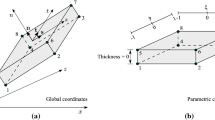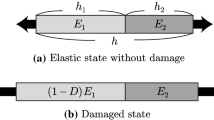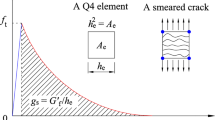Abstract
In brittle composite materials, failure mechanisms like debonding of the matrix-fiber interface or fiber breakage can result in crack deflection and hence in the improvement of the damage tolerance. More generally it is known that high values of fracture energy dissipation lead to toughening of the material. Our aim is to investigate the influence of material parameters and geometrical aspects of fibers on the fracture energy as well as the crack growth for given load scenarios. Concerning simulations of crack growth the cohesive element method in combination with the Discontinuous Galerkin method provides a framework to model the fracture considering strength, stiffness and failure energy in an integrated manner. Cohesive parameters are directly determined by DFT supercell calculations. We perform studies with prescribed crack paths as well as free crack path simulations. In both cases computational results reveal that fracture energy depends on both the material parameters but also the geometry of the fibers. In particular it is shown that the dissipated energy can be increased by appropriate choices of cohesive parameters of the interface and geometrical aspects of the fiber. In conclusion, our results can help to guide the manufacturing process of materials with a high fracture toughness.
Similar content being viewed by others
References
Barenblatt GI (1962) The mathematical theory of equilibrium cracks in brittle fracture. Adv Appl Mech 7: 55–129
Belytschko T, Black T (1999) Elastic crack growth in finite elements with minimal remeshing. Int J Numer Methods Eng 45: 601–620
Broedling NC, Hartmaier A, Gao H (2008) Fracture toughness of layered structures: embrittlement due to confinement of plasticity. Eng Fract Mech 75: 3743–3754
Camacho GT, Ortiz M (1996) Computational modelling of impact damage in brittle materials. Int J Solids Struct 33(20-22): 2899–2938
Chandra N, Li H, Shet C, Ghonem H (2002) Some issues in the application of cohesive zone models for metal-ceramic interfaces. Int J Solids Struct 39: 2827–2855
Curran DR, Seaman L, Cooper T, Shockey DA (1993) Micromechanical model for comminution and granular flow of brittle material under high strain rate application to penetration of ceramic targets. Int J Impact Eng 13(1): 53–83
Dugdale DS (1960) Yielding of steel sheets containing slits. J Mech Phys Solids 8: 100–104
Eshelby JD (1956) The continuum theory of lattice defects. In: Seitz F, Turnbull D (eds) Progress in solids state physics, vol 3. Academic Press, New York, p 79
Fleming M, Chu YA, Moran B, Belytschko T (1997) Enriched element-free galerkin methods for crack tip fields. Int J Numer Methods Eng 40: 1483–1504
Fritz A, Hüeber S, Wohlmuth BI (2004) A comparison f mortar and Nitsche techniques for linear elasticity. CALCOLO 41: 115–137
Geissler G, Kaliske M (2010) Time-dependent cohesive zone modelling for discrete fracture simulation. Eng Fract Mech 77(1): 153–169
Gonze X, Amadon B, Anglade PM, Beuken JM, Bottin F, Boulanger P, Bruneval F, Caliste D, Caracas R, Coté M, Deutsch T, Genovese L, Ghosez P, Giantomassi M, Goedecker S, Hamann D, Hermet P, Jollet G, Leroux S, Mancini M, Mazevet S, Oliveira M, Onida G, Pouillon Y, Rangel T, Rignanese GM, Sangalli D, Shaltaf R, Torrent M, Verstraete M, Zerah G, Zwanziger J (2009) ABINIT: first-principles approach to material and nanosystem properties. Comput Phys Commun 180(12): 2582–2615
Griffith AA (1921) The phenomena of rupture and flow in solids. Philos Trans R Soc Lond A 221: 163–198
Hohenberg P, Kohn W (1964) Inhomogeneous electron gas. Phys Rev 136(3B): 864–871
Irwin GR (1957) Analysis of stresses and strains near the end of a crack traversing a plate. J Appl Mech 24: 361–364
Irwin GR (1958) Fracture. In: Flügge S (eds) Encyclopedia of physics: elasticity and plasticity. Springer, Berlin, pp 551–590
Khludnev A, Leugering G (2009) On elastic bodies with thin rigid inclusions and cracks. Preprint-series of the Institute of Applied Mathematics, University of Erlangen-Nuremberg, 327
Kohn W, Sham LJ (1965) Self-consistent equations including exchange and correlation effects. Phys Rev 140(4A): 1133–1138
Krack M (2005) Pseudopotentials for H to Kr optimized for gradient-corrected exchange-correlation functionals. Theor Chem Acc 114(1): 145–152
Lung CW, Gao H (1985) Analysis of Kic and its temperature dependence of metals by a simplified dislocation model. Physica Status Solidi 87(2): 565–569
Martin R (2004) Electronic structure: basic theory and practical methods. Cambridge University Press, Cambridge
Maugin GA, Trimarco C (1992) Pseudomomentum and material forces in nonlinear elasticity: variational formulations and application to brittle fracture. Acta Mech 94: 1–28
Mergheim J, Kuhl E, Steinmann P (2004) A hybrid discontinuous Galerkin/interface method for the computational modelling of failure. Commun Numer Methods Eng 20: 511–519
Monkhorst HJ, Pack JD (1976) Special points for Brillouin-zone integrations. Phys Rev B 13(12): 5188–5192
Needleman A (1987) A continuum model for void nucleation by inclusion debonding. J Appl Mech 54(3): 525–531
Nitsche J (1971) Über ein Variationsprinzip zur Lösung von Dirichlet-Problemen bei Verwendung von Teilräumen, die keinen Randbedingungen unterworfen sind. Abhandlungen aus dem Mathematischen Seminar der Universität Hamburg 36(1): 9–15
Noels L, Radovitzky R (2008) An explicit disconitinuous galerkin method for non-linear solid dynamics: Formulation, parallel implementation and scalability properties. Int J Numer Methods Eng 74: 1393–1420
Ortiz M, Pandolfi A (1999) Finite-deformation irreversible cohesive elements for three-dimensional crack-propagation analysis. Int J Numer Methods Eng 44: 1267–1282
Perdew JP, Burke K, Ernzerhof M (1996) Generalized gradient approximation made simple. Phys Rev Lett 77(18): 3865–3868
Rice JR (1968) A path independent integral and the approximate analysis of strain concentraction by notches and cracks. J Appl Mech 35: 379–386
Rice JR, Sorensen EP (1978) Continuing crack-tip deformation and fracture for plane-strain crack growth in elastic-plastic solids. J Mech Phys Solids 26: 163–186
Rose JH, Smith JR, Ferrante J (1983) Universal features of bonding in metals. Phys Rev B 28(4): 1835–1845
Ruiz G, Pandolfi A (2000) Three-dimensional finite-element simulation of the dynamic Brazilian tests on concrete cylinders. Int J Numer Meth Eng 48(7): 963–994
Stumpf H, Le KC (1990) Variational principles of nonlinear fracture mechanics. Acta Mech 83: 25–37
Tvergaard V, Hutchinson JW (1993) The influence of plasticity on mixed mode interface toughness. J Mech Phys Solids 41(6): 1119–1135
Walter ME, Ravichandran G, Ortiz M (1997) Computational modeling of damage evolution in unidirectional fiber reinforced ceramic matrix composites. Comput Mech 20: 192–198
Xu XP, Needleman A (1994) Numerical simulations of fast crack growth in brittle solids. J Mech Phys Solids 42(9): 1397–1434
Yang B, Ravi-Chandar K (1998) A single-domain dual-boundary-element formulation incorporating a cohesive zone model for elastostatic cracks. Int J Fract 93: 115–144
Yoo MH, Yoshimi K (2000) An empirical model for ideal work of adhesion: transition-metal aluminides and silicides. Intermetallics 8(9-11): 1215–1224
Zhang H, Wang S (2007) First-principles study of Ti3AC2 (A=Si, Al) (001) surfaces. Acta Materialia 55(14): 4645–4655
Author information
Authors and Affiliations
Corresponding author
Rights and permissions
About this article
Cite this article
Prechtel, M., Ronda, P.L., Janisch, R. et al. Simulation of fracture in heterogeneous elastic materials with cohesive zone models. Int J Fract 168, 15–29 (2011). https://doi.org/10.1007/s10704-010-9552-z
Received:
Accepted:
Published:
Issue Date:
DOI: https://doi.org/10.1007/s10704-010-9552-z




